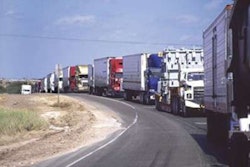On Tuesday, Feb. 1, Qualcomm Enterprise Services (QES) provided this CCJ editor with an online training session for CSA Safety Performance Service, which became commercially available as of Jan. 20.
Qualcomm says it developed CSA Safety Performance Service as a one-stop source of information for the Federal Motor Carrier Safety Administration’s (FMCSA) Compliance, Safety, Accountability (CSA) program. The information is pulled in from two sources: the CSA Safety Measurement System (SMS) and from relevant Qualcomm services data (Qualcomm Hours of Service, Critical Event Reporting and Performance Monitoring).
Along with creating a one-stop source of CSA information, Qualcomm has designed a closed-loop management process for the violations, interventions, citations, accidents and other data elements used in the SMS scoring methodology.
Visually the application appears simple and easy to navigate starting with the dashboard layout of the main menu. Large icons present the screens fleets use to manage the different components of CSA performance.
To use the new service, a fleet administrator would first establish peer groups for reporting CSA performance. Peer groups help visualize and compare driver safety and compliance by fleet manager, geographic location, equipment type, etc.
In the future, Qualcomm will be able to use these peer groups to create benchmarking capabilities using the collective data of its customers, says Jim Sassen, senior manager of product marketing, who led the online training session.
Data Services is another screen accessible from the main menu. This screen lets users select which Qualcomm services data to incorporate into the program. Qualcomm services data can help users see performance issues that correlate with violations and the other driver and vehicle inspection data that falls into one of seven safety assessment categories, called BASICs, in the CSA program.
A Data Services screen lets users set driver performance thresholds by time period — week, month, etc. — and generate action plans when the thresholds are breached. Users can assign points to each incident to indicate severity, Sassen says, and select which managers to send notifications to (via text or email) for each data point.
The Manage Accident Data screen enables users to see a report of all DOT-reportable accident data in the SMS database. Carriers can also include non-reportable accidents as well from their own safety databases, Sassen says.
Similarly, a Manage Violation Data screen shows all inspections and violations to date with hyperlinks to a library of definitions for each type of violation. With a few clicks, users can create reports for this data in any type — tables, maps, line, bar charts, etc. — and print, email or export to a spreadsheet.
The Driver Scores screen lets users look across an entire fleet to see drivers with the highest SMS scores and focus resources on who needs training, what actions are required in the coaching plan, and what actions have been taken.
The Manager Summary Report is a screen that lets users see trends for SMS data and the Qualcomm data that correlates — by driver and by peer groups. Also, each driver is given an SMS score and a Qualcomm score to help managers anticipate future violations, Sassen says.
Qualcomm’s CSA Safety Performance Service comes in Basic and Deluxe offerings. The Basic offering has FMCSA SMS data and reporting tools but does not have the Qualcomm data or the training and remediation components. The Deluxe version has both data sources and the training and remediation pieces.
Overall, Sassen says the key features of CSA Safety Performance Service are: 1) a single portal for CSA information; 2) the ability to correlate Qualcomm data with SMS data for proactive management; 3) the ability to create peer groups and user hierarchies; and 4) flexible reporting tools that allow users to view and share information.











